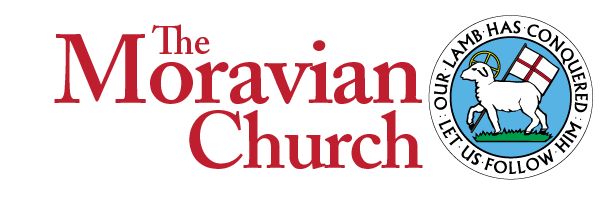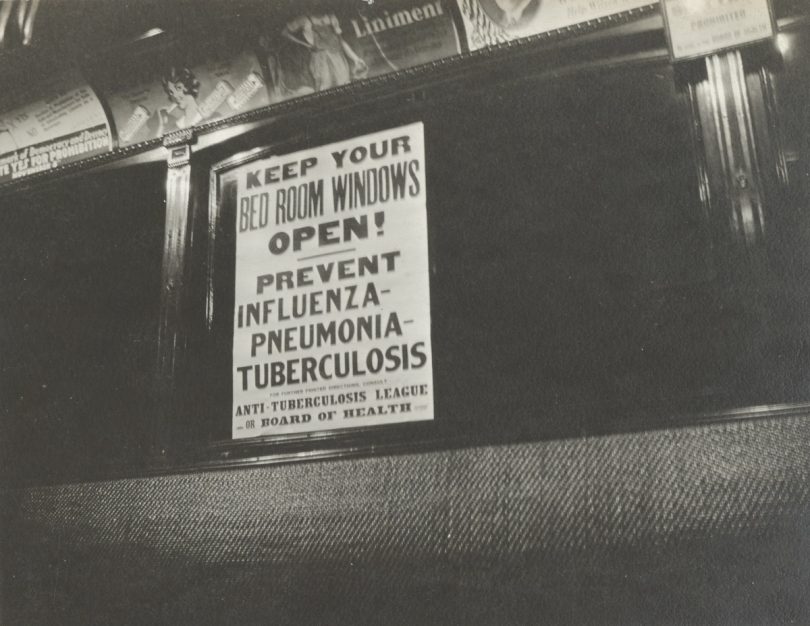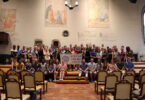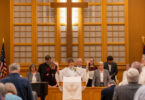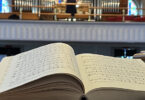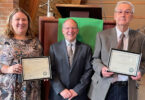Bethlehem may have escaped the yellow fever epidemic in 1793; however, the town was not so fortunate during the Spanish flu pandemic of 1918. The Spanish flu came in waves and the second wave hit Bethlehem that October.
To better understand the events of 1918, it is helpful to look at what else was going on at Central Moravian Church in Bethlehem before the outbreak of the pandemic later that year. For months, there had already been restrictions on the ability to worship caused by the First World War. The number of services was reduced in order to save fuel while the Old Chapel and the Sunday School Chapel were not used during colder months. Daylight Saving Time was introduced as another measure to save fuel. And in order to save food, no coffee or buns were distributed during the lovefeasts that year. The weather was particularly bad in 1918: a heavy hailstorm on May 27 caused wide-spread damage to trees and crops and even destroyed two loading cranes at the Bethlehem Steel plant. On top of that, an unusual frost at the end of June did further damage to the vegetation.
But there were other developments as well. During the summer, Central welcomed Bro. Samuel Gapp as its new pastor. The parade on the Fourth of July was larger than ever before: it took two hours for the parade to pass. In August, the annual Sunday School picnic was held in the grounds of the Young Ladies’ Seminary, today the south campus of Moravian College. For the first time in the history of Bethlehem Communion service was not offered in German for the celebration of the August 13th festival. Earlier that year, the church elders had decided to end all German-language services. At the children’s festival the church lawn was decorated with American flags. Every service ended with the singing of a special hymn for the military. Many Moravians attended a patriotic community service in the Bethlehem Steel Athletic Field on the corner of Elizabeth Avenue and Center Street on September 15. On Monday, September 30, Moravian College and Theological Seminary held their opening service in the church, and then—the pandemic hit.
Though most of us have never lived through a pandemic before, the Moravian Church has. In a second of two articles, I will explore how Moravians, especially in Bethlehem, have dealt with earlier epidemics. This month: the Spanish flu pandemic of 1918.
—Paul Peucker, Northern Province archivist
On Wednesday, October 2, the first cases of Spanish flu were reported at Moravian College. The entire college was immediately put under “strict military quarantine.” The disease spread quickly. Because of the vital role Bethlehem Steel played in the ongoing war, measures in Bethlehem were particularly strict. Brother Gapp wrote in the congregational diary:
“Cases of Spanish influenza are reported to be increasing rapidly— frequently leading to a malignant form of pneumonia and causing death. To avert an epidemic and protect the output of munitions for the war by the Bethlehem Steel Company, the health board at noon closed all saloons, schools, theatres and forbad all public meetings, except churches and Sunday schools next Sunday.”
Although people were scared of the pandemic, 145 people attended the morning service at Central that Sunday. It would be the last church service for weeks. The midweek service on Wednesday night was the first to be canceled.
On October 10 there were between 700 and 800 cases of the flu in Bethlehem. Although the number of infections was high, there were not many deaths at that point.
Two days later the total number of cases passed one thousand. The disease was also spreading among Moravians. Sometimes entire families were infected. Fortunately, the diary noted, “the death rate is much lower here than in other places. So often the influenza superinduces a malignant form of pneumonia.”
On Sunday, October 13, no church services were held anywhere in Bethlehem. Brother Gapp spent the day making house visits, although “at many places I could only call at the door.” The following day, a trolley went off the tracks in South Bethlehem and hit a pole. Three people were killed and eighteen were injured.
In international news, there were rumors about a German peace offer. President Wilson insisted on an unconditional surrender.
Meanwhile, the number of cases of Spanish flu kept increasing. Six deaths were reported in town on October 15 with nine more the next day. In comparison, forty deaths were reported in nearby Easton and Philipsburg that same day. In Easton funeral homes ran out of coffins and funeral services had to be postponed. Beginning on October 16 only private burials were allowed as the local Health Board no longer allowed public funerals. Choirs were not allowed at funerals. From then on, Moravian funerals took place without choir or trombones, something that under normal circumstances was hard to imagine.
October 20 was the second Sunday without any services. Again, Gapp spent the day making house visits. Even with restrictions in place, Gapp did attend the meeting of the Hymnal Committee in New York City that week. Influenza cases remained high, especially in South Bethlehem.
News about fallen soldiers was also coming in. Theodore Shields, member of the congregation, died in France of pneumonia, most likely caused by the Spanish flu.
By early November, however, things were turning around. “Influenza is abating,” Gapp wrote. November 3 was believed to be the last Sunday without worship. November 5 was election day. “Very little interest shown in the matter in town,” Gapp wrote.
On Wednesday, November 6, at 6 o’clock in the morning, the quarantine was lifted. All schools opened, but although it was a Wednesday, no evening service could be arranged so quickly. The total number of cases reported in Bethlehem so far exceeded 3,100. And even though the town was relieved the quarantine had been lifted, the pandemic was far from over. Within a half hour Gapp was informed of three deaths–all influenza related. One was Walter Shields, who died of influenza in Alaska. Walter was the brother of Theodore Shields, who had recently died from influenza in France.
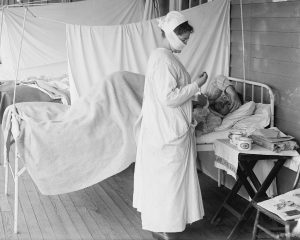 On Thursday, November 7, bells and whistles were heard everywhere in town and rumors spread that the U.S. army had conquered Sedan in France from the Germans; 20,000 deserted German soldiers were supposedly marching in Berlin; and Germany had signed the armistice. People in Bethlehem were overjoyed: steel workers paraded through the streets, which were jammed with people. An improvised parade was held that same evening. Gapp wrote: “The enthusiasm and joy of the people is quite indescribable. The common belief is that Germany must soon sign the armistice and that the horrible war is practically over.” The happiness over the end of the quarantine was combined with immense joy over the end of the war.
On Thursday, November 7, bells and whistles were heard everywhere in town and rumors spread that the U.S. army had conquered Sedan in France from the Germans; 20,000 deserted German soldiers were supposedly marching in Berlin; and Germany had signed the armistice. People in Bethlehem were overjoyed: steel workers paraded through the streets, which were jammed with people. An improvised parade was held that same evening. Gapp wrote: “The enthusiasm and joy of the people is quite indescribable. The common belief is that Germany must soon sign the armistice and that the horrible war is practically over.” The happiness over the end of the quarantine was combined with immense joy over the end of the war.
But—it was not true; Germany had not signed anything and the war was not over. This day would become known as “False Armistice Day.” Gapp wrote: “The entire U.S. yesterday celebrated an event that has not yet taken place.” The disillusion was almost too difficult to bear.
On Sunday, November 10, the first Sunday morning worship service took place with a large attendance. And the following day, Monday, November 11, the war was finally over. Gapp wrote:
“At quarter of five, the Bethlehem Steel Company whistles started to blow; by 5 o’clock it was known all over town that Washington had confirmed the signing of the armistice, and the noise in the town was terrific. In a short time everybody was on the streets — one impromptu parade followed another— everybody waving flags, singing, shouting. Bands, drum-corps, old boilers and tin-cans— all helped to swell the volume of noise. This kept up practically all day— there was no work,— shops, factories, stores, schools,— all closed. At two o’clock p.m. a parade formed at Broad and Main Streets and marched through town— the biggest parade ever seen here. Some of the floats were not dignified—as one might expect in so spontaneous an affair— such as the Kaiser dangling from a gallows, or in a coffin which was ceremoniously heaved over the Broad Street Bridge into the water below. The jubilation continued till late in the night.”
On Wednesday, November 13, the church was packed for an ecumenical Peace Thanksgiving Service: “Our choir with full orchestra and trombone accompaniment rendered the Hallelujah Chorus in a very impressive manner.”
And that is how the quarantine and the war ended within the same week. Life returned to normal, but life did not necessarily become better. The following week, Bethlehem Steel laid off 1,500 men. People continued to die from the flu. The Health Board issued a warning to remain careful and ordered that all funerals were to be kept private. Because of the high number of cases, nurses were hard to find.
On December 10 government restrictions on food and fuel ceased. Sickness remained high in Bethlehem, “but in a milder form than the recent epidemic.” The church was decorated for Christmas again and Christmas services took place. The year of 1918 came to an end.
Looking back at 1793 and 1918 I see many parallels with today’s situation. Jacob Ettwein, the man who refused to quarantine and follow the rules of the Bethlehem health committee, reminds me of those I see screaming on TV and posting on Facebook that this is all a hoax. Like 2020, 1918 was a particularly bad year: limited food supplies, restrictions on fuel, hailstorms and frost in late June, and last but not least: no lovefeast buns. Like today, there were elections in 1918. However, they were not presidential elections and public interest, as Brother Gapp noted in the diary, was low.
I am especially impressed with the work of the health committee of 1793. They were organized, proactive, and well informed. Some of the measures they took remind me of today’s measures: travel restrictions, quarantines, setting up medical supplies and preparing locations to take care of the sick. This was the advantage of living in a well-organized community such as Bethlehem. There were structures in place, Moravians were generally educated people, and there was a trained local doctor.
There was also unsubstantiated fear in both cases: the man in the Brothers’ House in 1793 who did not have yellow fever but rather only too much to drink was still put under quarantine outside of Bethlehem because people were too scared to completely trust the doctor. There were the mistaken remedies and medical theories: the use of Black nurses because Blacks allegedly were immune to the flu. Today there are the debunked “wonder cures:” hydroxy-chloroquine tablets, UV light treatments, and gargling with salt water.
But there are differences as well. Both the 1793 yellow fever epidemic and the 1918 Spanish flu pandemic lasted several weeks. We just passed one year in this pandemic, with the end uncertain. I am sure you are as ready as I am for all this to be over.
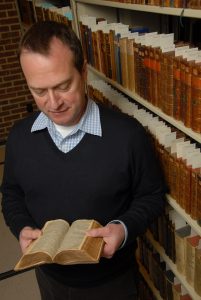 Dr. Paul Peucker is the archivist for the Moravian Church Northern Province Archives.
Dr. Paul Peucker is the archivist for the Moravian Church Northern Province Archives.
